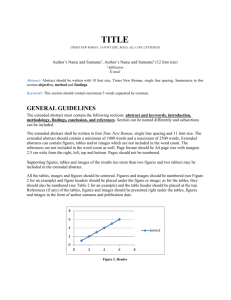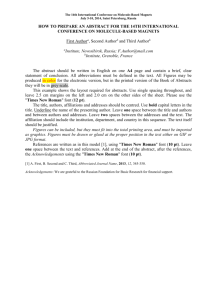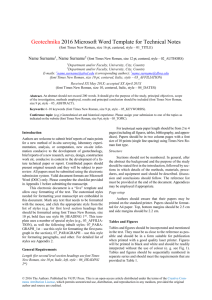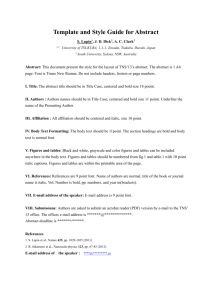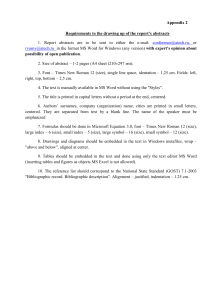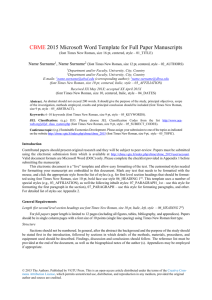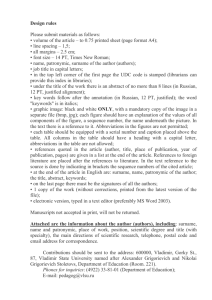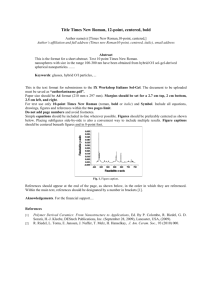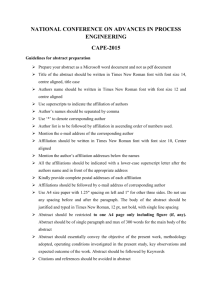research_paper - 13bsgc - 13 Baltic Sea Geotechnical
advertisement
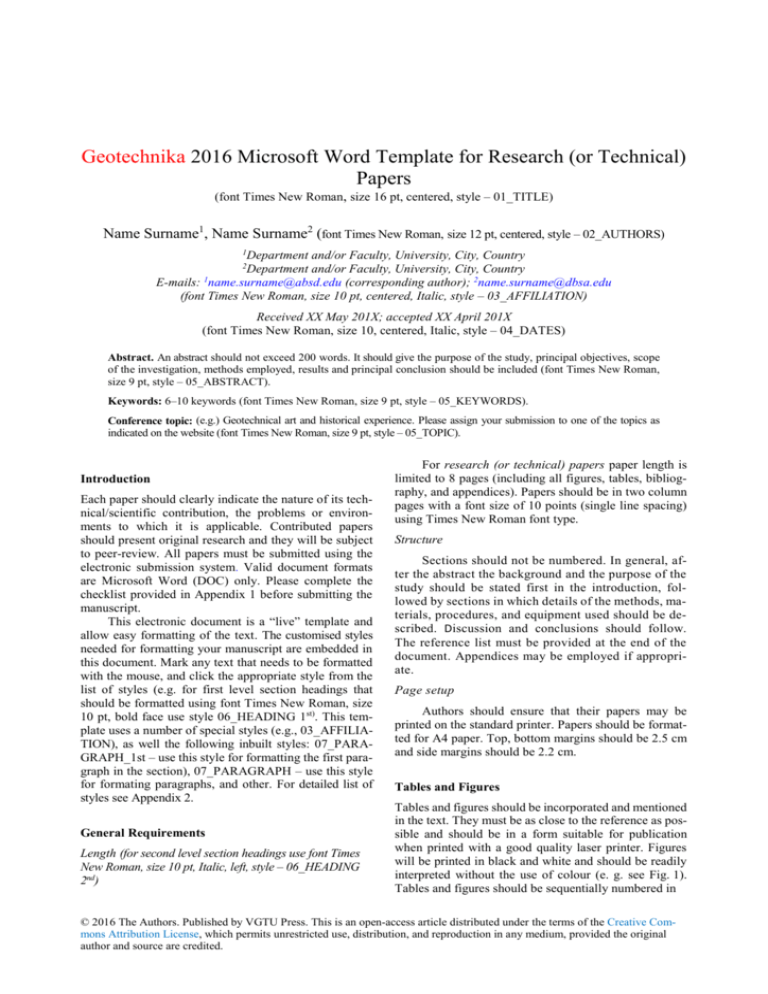
Geotechnika 2016 Microsoft Word Template for Research (or Technical)
Papers
(font Times New Roman, size 16 pt, centered, style – 01_TITLE)
Name Surname1, Name Surname2 (font Times New Roman, size 12 pt, centered, style – 02_AUTHORS)
1
Department and/or Faculty, University, City, Country
Department and/or Faculty, University, City, Country
E-mails: 1name.surname@absd.edu (corresponding author); 2name.surname@dbsa.edu
(font Times New Roman, size 10 pt, centered, Italic, style – 03_AFFILIATION)
2
Received XX May 201X; accepted XX April 201X
(font Times New Roman, size 10, centered, Italic, style – 04_DATES)
Abstract. An abstract should not exceed 200 words. It should give the purpose of the study, principal objectives, scope
of the investigation, methods employed, results and principal conclusion should be included (font Times New Roman,
size 9 pt, style – 05_ABSTRACT).
Keywords: 6–10 keywords (font Times New Roman, size 9 pt, style – 05_KEYWORDS).
Conference topic: (e.g.) Geotechnical art and historical experience. Please assign your submission to one of the topics as
indicated on the website (font Times New Roman, size 9 pt, style – 05_TOPIC).
Introduction
Each paper should clearly indicate the nature of its technical/scientific contribution, the problems or environments to which it is applicable. Contributed papers
should present original research and they will be subject
to peer-review. All papers must be submitted using the
electronic submission system. Valid document formats
are Microsoft Word (DOC) only. Please complete the
checklist provided in Appendix 1 before submitting the
manuscript.
This electronic document is a “live” template and
allow easy formatting of the text. The customised styles
needed for formatting your manuscript are embedded in
this document. Mark any text that needs to be formatted
with the mouse, and click the appropriate style from the
list of styles (e.g. for first level section headings that
should be formatted using font Times New Roman, size
10 pt, bold face use style 06_HEADING 1st). This template uses a number of special styles (e.g., 03_AFFILIATION), as well the following inbuilt styles: 07_PARAGRAPH_1st – use this style for formatting the first paragraph in the section), 07_PARAGRAPH – use this style
for formating paragraphs, and other. For detailed list of
styles see Appendix 2.
General Requirements
Length (for second level section headings use font Times
New Roman, size 10 pt, Italic, left, style – 06_HEADING
2nd)
For research (or technical) papers paper length is
limited to 8 pages (including all figures, tables, bibliography, and appendices). Papers should be in two column
pages with a font size of 10 points (single line spacing)
using Times New Roman font type.
Structure
Sections should not be numbered. In general, after the abstract the background and the purpose of the
study should be stated first in the introduction, followed by sections in which details of the methods, materials, procedures, and equipment used should be described. Discussion and conclusions should follow.
The reference list must be provided at the end of the
document. Appendices may be employed if appropriate.
Page setup
Authors should ensure that their papers may be
printed on the standard printer. Papers should be formatted for A4 paper. Top, bottom margins should be 2.5 cm
and side margins should be 2.2 cm.
Tables and Figures
Tables and figures should be incorporated and mentioned
in the text. They must be as close to the reference as possible and should be in a form suitable for publication
when printed with a good quality laser printer. Figures
will be printed in black and white and should be readily
interpreted without the use of colour (e. g. see Fig. 1).
Tables and figures should be sequentially numbered in
© 2016 The Authors. Published by VGTU Press. This is an open-access article distributed under the terms of the Creative Commons Attribution License, which permits unrestricted use, distribution, and reproduction in any medium, provided the original
author and source are credited.
Surname, N.; Surname, N. Year. Full title
Table 1. Table captions should be centered and placed above the table (font Times New Roman, size 9 pt, style – 10_TABLE).
Include a single empty line in the Normal style after the table (Source: ...)
Font
Line thickness
File formats
Tables
Times New Roman 9 pt
0.5 pt
*.doc, *.docx
Photos and images (resolution –
no less than 300 dpi)
–
–
*.jpg, *.tiff, *.gif, *.png
Diagrams, charts, schemes
Times New Roman
from 5 to 8 pt
From 0.3 to 2 pt
*.pdf, *.eps, *.cdr, *.xls, *.xlsx,
*.dwg
separate series and should meet the requirements that are
provided in Table 1.
Fig. 1. Figure captions should be centered and placed below
the figure
(font Times New Roman, size 9 pt, style – 08_FIGURE).
Include a single empty line in the Normal style before
the figure (Source: ...)
Care and attention must be given to below guidelines because importing graphics packages can often be problematic:
All figures and tables must be placed and cited in
the text in consecutive numerical order. In multipart figures, each part should be labelled, e.g.
Fig. 1a, Fig. 1b.
The resolution of pictures should be no less than
300 dpi (dots per inch). If the size of the final file
is too large (more than 10 MB), then the manuscript should contain the figures with minimised
resolution, and the original figures must be provided in separate files.
Figures in separate files should be saved in appropriate formats (see Table 2). The file name for
the graphics should include their short description (e.g. Fig_1, Fig_2a).
Figures, e.g., a diagram, must be inserted as a pure
‘image’ using the Word ‘Insert special’ option in the ‘Editing’ menu. The image should be fixed in relation to the
text body by using the ‘Image’ option in the ‘Format’
menu. From the ‘Image’ option one selects the ‘Layout’
entry, followed by the ‘In-line-with-text’ option and carriage return. In Office 2007, insert the Image using the
‘Paste Special...’ function accessible from under the Paste
icon on the Home pane.
2
Formulas and Equations
Formulas, equations and their components presented in
the text must be written in Equation Editor. The size of
basic symbols in equations should correspond to the letter
size of the main text (10 pt). To do that, modify “Full”
and “Sub-symbol” parameters in “Size/Define” toolbar
of the Equation Editor: main symbols – 10 pt, indexes –
7 pt, sub-indexes – 6 pt (see Fig. 2).
Fig. 2. Equation Editor options
All the numerals, including index numbers, are presented
in Regular type, variables in Italic. Matrices are written
in square brackets [ ] and vectors in figurative brackets
{ }. Equations should be formatted in Times New Roman
10 pt. Punctuate equations with commas or periods when
they are a part of a sentence, as in
a
b
(style – 09_ DISPLAYED_EQUATION), (1)
c
where: a – explanation; b – explanation, etc. (all symbols
must be explained).
Please confine equations to one column width – 8 cm. If
the equation is longer, it should be split at appropriate algebraic symbols. Equations are numbered by Arabic numerals in round brackets and aligned right. The punctuation and numbers of longer equations, like (2), must be
vertically centred with the last line of the equation. The
parts of the longer equations must be horizontally left
aligned in the Equation Editor.
Lcoaxial
q
0 ln
2 p 0
r 2
1
.
2
2 r q 2
r4
r 2 q2
2
ln
r
q
(2)
Surname, N.; Surname, N. Year. Full title
Use an en-dash (–) rather than a hyphen (-) for a minus
sign. Please note that an en-dash should be used for connecting values (years, tables, figures, equations, etc.) in a
range; for connecting variables in a range, please use ÷,
or “from … to …” construction. Reformatting of running
text, into which special characters such as Greek letters
have been entered via the keyboard, can cause these characters to disappear. In order to avoid this problem, always
insert special characters to your document from Insert →
Symbol. In the Symbol dialog box select the required
character and click Insert.
Reference Style
For your convenience you can use VGTU citation style
on Mendeley (for detailed instructions see
http://leidykla.vgtu.lt/en/component/content/article/145.html). Should you choose another system, please
follow the instructions below.
The Harvard (name and year) short reference system is used for citations in the text with a detailed alphabetical list at the end of the paper. If the sources have
more than two researchers, only the surname of the first
author should be indicated (e.g. Burkart et al. 2012). In
case the list of references includes persons bearing the
same surnames, the first letter of the author’s name
should be indicated, e.g. (Edwards, M. R., Edwards, T.
2013). Sources of the same author and the same year
should be mentioned in the following way (Ulrich 2012a,
2012b). For formatting references use font Times New
Roman, size 9 pt, style –11_REFERENCES. Follow reference requirements below when preparing your list of
references (for examples, see section Reference):
For a book with a single author (Greene 2012),
the following information should be indicated:
surname, first name initial, year, title of the book,
and publisher;
For a book with two authors (Cullen, Praveen
Parboteeah 2011), the following information
should be indicated: surnames, first name initials,
year, title of the book, and publisher;
For conference proceedings (Gawer 2012), the
following information should be indicated: surname(s), first name initial(s), year, title of the article, title of the conference, date (day and month)
and place (city and country) of the conference,
and page numbers;
For thesis or dissertation (see Virtanen 2011), the
following information should be indicated: surname, first name initial(s), year, title of the thesis,
city, university;
For chapters or parts of edited works included in
collections or textbooks (Agrawal, Knoeber
2012), the following information should be indicated: surname, first name initial(s), year, title of
the chapter, name initials and surnames of editors, title of the book, publisher, and page numbers;
For journal articles (MacNab, Worthley 2013;
Edwards, M. R., Edwards, T. 2013; Ulrich 2012a,
2012b), the following information should be indicated: surname(s), first name initial(s), year, title of the article, title of the journal, volume, issue
and page numbers;
For Internet documents (ENISA 2010), the following
information should be indicated: surname(s), first
name initial(s), year, title of the article, working direct link to the source cited and the date of citation
(day, month, year);
For non-book and other formats (Frontier Economics 2011).
Please use the transliterated (not translated) version of the
names and sources in Cyrillic. For papers published in the
journals available in two or more languages, please give the
English citation first, followed by the original language citation.
Conclusions
Conclusions or generalizations about your research
should be presented.
Acknowledgements
People who contributed to the work should be listed in
the acknowledgments, along with their contributions.
You must ensure that anyone named in the acknowledgments agrees to being named.
Funding
Funding sources should be included in the form of a sentence as follows, with the funding agency written out in full,
followed by the grant number in square brackets: This work
was supported by the Medical Research Council [grant
number 1111].
Multiple grant numbers should be separated by
comma and space. Where the research was supported by
more than one agency, the different agencies should be
separated by semi-colon, with “and” before the final funder. Thus:
This work was supported by the Welcome Trust
[grant numbers 1111, 2222]; the Natural Environment
Research Council [grant number 3333]; and the Economic and Social Research Council [grant number
4444]
Contribution
Authors are welcome to declare any involvement in writing a manuscript (e.g. conception and design of the work,
acquisition of data, or analysis and interpretation of data,
drafting the article or revising it critically for important
intellectual content, etc.).
Disclosure Statement
Authors are required to include a statement at the end of
their article to declare whether or not they have any competing financial, professional, or personal interests from
other parties.
3
Surname, N.; Surname, N. Year. Full title
References
Agrawal, A.; Knoeber, Ch. R. 2012. Corporate governance and
firm performance, Chapter 26 in Christopher, R. T.;
Shughart, W. F. (Eds.). Managerial economics. New
York, NY: Oxford University Press. (For formatting
references use font Times New Roman, size 9 pt, style –
11_REFERENCES).
Burkart, W. R.; Klein, R.; Mayer, S. 2012. Product line pricing
for services with capacity constraints and dynamic
substitution, European Journal of Operational Research
219(2): 347–359.
Cullen, J. B.; Praveen Parboteeah, K. 2011. Multinational
management: a strategic approach. 5th ed. Mason: Thomson
South-Western.
Edwards, M. R.; Edwards, T. 2013. Employee responses to
changing aspects of the employer brand following a multinational acquisition: a longitudinal study, Human Resource Management 52: 27–54.
ENISA. 2010. Portugal Country Report 2009–2010. European
Network and Information Security Agency. Available
from Internet:
http://www.epractice.eu/en/document/288342
Frontier Economics. 2011. Estimating the global economic and
social impacts of counterfeiting and piracy. A report
commissioned by business action to stop counterfeiting
and piracy (BASCAP). Frontier Economics Ltd, London.
Gawer, J. 2012. Corporate governance scores and long term
performance, in 29th International Conference of the
French Finance Association, 15–16 May 2012,
Strasbourg, France.
Greene, W. H. 2012. Econometric analysis. 7th ed. New Jersey:
Prentice Hall.
MacNab, B. R.; Worthley, R. 2013. Stereotype awareness
development and effective cross-cultural management –
an experimental approach, International Journal of Cross
Cultural Management 13(1): 67–87.
Ulrich, W. 2012a. Operational research and critical systems
thinking – an integrated perspective Part 1: OR as applied
systems thinking, Journal of the Operational Research
Society 63(9): 1228–1247.
http://doi.dx.org/10.1057/jors.2011.141
Ulrich, W. 2012b. Operational research and critical systems
thinking – an integrated perspective Part 2: OR as
argumentative practice, Journal of the Operational
Research Society 63(9): 1307–1322.
http://doi.dx.org/10.1057/jors.2011.145
Virtanen, M. 2011. Choosing the optimal energy system for
buildings and districts: Master’s thesis. Lappeenranta
University of Technology.
Appendix 1
Submission Checklist
Indicate that this submission is ready to be considered by this conference by checking off the following (comments to the director
can be added below):
The submission has not been previously published, nor is it before another conference for consideration (or an explanation has been provided in Comments to the Director).
The submission file is Microsoft Word document file format.
All URL addresses in the text (e.g., http://pkp.sfu.ca) are activated and ready to click.
The text is single-spaced; uses a 10 point font; employs italics, rather than underlining (except with URL addresses)
and all illustrations, figures, and tables are placed within the text at the appropriate points, rather than at the end.
All illustrations, figures, and tables are mentioned in the text and are placed within the text at the appropriate points,
rather than at the end.
The text adheres to the stylistic and bibliographic requirements outlined in this template.
Copyright Notice
Authors who submit to this conference agree to the following terms:
Authors retain copyright over their work, while allowing the conference to place this unpublished work under a Creative
Commons Attribution License, which allows others to freely access, use, and share the work, with an acknowledgement
of the work's authorship and its initial presentation at this conference.
Authors are able to waive the terms of the CC license and enter into separate, additional contractual arrangements
for the non-exclusive distribution and subsequent publication of this work (e.g., publish a revised version in a journal, post it to an institutional repository or publish it in a book), with an acknowledgement of its initial presentation
at this conference.
In addition, authors are encouraged to post and share their work online (e.g., in institutional repositories or on their
website) at any point before and after the conference.
The authors agree to the terms of this Copyright Notice, which will apply to this submission if and when it is published by this
conference
4
Surname, N.; Surname, N. Year. Full title
Appendix 2
List of styles embedded in this document
Size
Alignment
Style
Title
16 pt
Centered
01_TITLE
Author names
12 pt
Centered
02_AUTHORS
Affiliation
10 pt
Centered, Italic
03_AFFILIATION
Received and accepted dates
10 pt
Centred, Italic
04_DATES
Abstract
9 pt
Justified
05_ABSTRACT
Keywords
9 pt
Justified
05_KEYWORDS
Topic
9 pt
Justified
05_TOPIC
First level section headings
10 pt
Left, Bold
06_HEADING 1st
Second level section headings
10 pt
Left, Italic
06_HEADING 2nd
Main Text without indentation
10 pt
Justified
07_PARAGRAPH_1st
Main Text with indentation 0,75 cm
10 pt
Justified
07_PARAGRAPH
Figure captions
9 pt
Centered
08_FIGURE
Equation centred 8 cm, number – right, 16,5 cm
10 pt
Centred
09_DISPLAYED_EQUATION
Table captions
9 pt
Centered
10_TABLE
Table text
9 pt
Left
References list
9 pt
Justified
10_TABLE_line
11_REFERENCES
Bullets, indentation 0,75 cm
10 pt
Justified
12_BULLETS
Numbering
10 pt
Justified
12_NUMBERING
5
